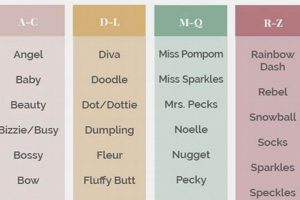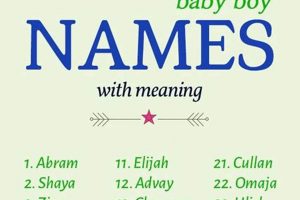Books created specifically for infants, incorporating the child’s given name within the narrative and illustrations, offer a distinct and tailored reading experience. For example, a story might feature the infant’s name as the protagonist, shaping the plot around their imagined adventures or characteristics.
The significance of such individualized books lies in their potential to foster early literacy and a sense of self. By seeing their name prominently displayed, infants may develop a stronger connection to the act of reading and a positive self-image. Historically, the creation of custom books was a laborious and costly endeavor, now readily accessible through digital printing technologies and online platforms, making it a viable option for many families.
The following sections will delve into the various aspects of these customized literary items, examining design considerations, age appropriateness, potential educational value, and the evolving landscape of their production and distribution.
Essential Considerations for Personalized Baby Books
Selecting a customized book for an infant requires careful consideration of several factors to ensure age-appropriateness, developmental suitability, and enduring value.
Tip 1: Confirm Age Appropriateness: Verify the book’s content and materials align with the infant’s developmental stage. Thick board pages are recommended for durability and ease of handling. Avoid books with small, detachable parts that present a choking hazard.
Tip 2: Assess Print Quality and Durability: High-quality printing ensures vibrant illustrations and legible text that will withstand repeated handling. Consider books printed with non-toxic inks on durable, tear-resistant paper or board.
Tip 3: Review Story Content and Length: The narrative should be engaging, simple, and age-appropriate, reflecting familiar objects and experiences. Shorter stories with repetitive phrases are often preferred by infants.
Tip 4: Choose Durable and Safe Materials: The physical composition of the book is paramount. Opt for books made from materials that are free from harmful chemicals and designed to endure frequent use.
Tip 5: Prioritize Educational Value: Select books that promote early literacy skills, such as recognizing colors, shapes, or animals. Consider books that incorporate interactive elements like lift-the-flaps or textures.
Tip 6: Evaluate Personalization Options: Assess the level of customization offered. Ensure the name is seamlessly integrated into the story and illustrations, creating a cohesive and engaging narrative.
Tip 7: Check Reviews and Reputation: Research the publisher or vendor to ensure they have a proven track record for quality, customer service, and adherence to safety standards.
By prioritizing safety, durability, and educational value, these customized books can become cherished keepsakes that contribute to an infant’s early learning and development.
The subsequent discussion will focus on the creative elements involved in designing and personalizing these unique literary gifts.
1. Name Integration
The success of books created specifically for infants that include their name hinges fundamentally on the quality of the integration. The inclusion of the name must move beyond mere insertion; it must be woven intrinsically into the narrative and visual elements. A poorly integrated name appears as an afterthought, diminishing the personalization and potentially disrupting the flow of the story. For example, a book intending to teach about animals may introduce each animal with the phrase “Here is [Child’s Name]’s Lion,” which feels contrived and lacks narrative depth.
Conversely, effective integration involves creating a story where the child’s name directly affects the plot or character interactions. This may involve the protagonist sharing the child’s name and embarking on adventures tailored to their imagined interests or characteristics. An example would be a story where “Sophia” discovers a magical garden filled with flowers that bloom in her favorite colors, with each flower bearing her initial. This level of integration requires careful planning and creative execution, ensuring that the name enhances rather than detracts from the overall reading experience. Furthermore, well-integrated names promote engagement and enhance the child’s sense of ownership and connection to the book.
The understanding of name integration in infant books illuminates a critical aspect of personalized content creation. The challenge lies in moving beyond superficial personalization to create meaningful and engaging narratives. A book that thoughtfully integrates the infant’s name becomes more than a story; it transforms into a unique keepsake that fosters a sense of self and encourages early literacy. Name integration is not merely a feature, but a core element defining the value and impact of individualized baby books.
2. Age Appropriateness
Age appropriateness serves as a cornerstone in the selection and creation of books designed for infants, particularly those personalized with the child’s name. The cognitive and physical capabilities of a developing infant dictate the type of content that is both engaging and beneficial, making age appropriateness a critical factor in ensuring a positive reading experience and fostering early literacy skills.
- Content Complexity
Infants at different stages of development possess varying levels of cognitive understanding. Newborns and young infants benefit from simple, repetitive narratives featuring basic shapes, colors, and familiar objects. As infants mature, more complex storylines and vocabulary can be introduced. A story about a baby named “Leo” exploring different textures, such as smooth silk and rough sandpaper, is appropriate for a younger infant, while a story about “Leo” going on a pretend adventure to find hidden animals may be better suited for an older infant or toddler.
- Physical Attributes
The physical design of the book must align with an infant’s motor skills and safety considerations. Board books with thick, durable pages are recommended to withstand handling and prevent tearing. Rounded corners minimize the risk of injury. Features such as lift-the-flaps should be securely attached to prevent choking hazards. Furthermore, illustrations should be visually stimulating but not overly detailed, as infants have limited visual processing capabilities.
- Sensory Stimulation
Infants learn through sensory exploration. Books can incorporate textures, sounds, and bright colors to engage their senses. However, sensory stimulation must be balanced to avoid overwhelming the infant. For instance, a book featuring “Emily” may include a soft patch of fabric to represent her favorite blanket, but the fabric must be securely attached and non-toxic. Sound elements should be appropriately volume-controlled to prevent startling the infant.
- Developmental Milestones
Content should be tailored to support developmental milestones, such as language acquisition and object recognition. Personalized books can incorporate simple words related to the child’s environment, such as “Mama,” “Papa,” or names of familiar objects. For instance, a book about “Noah” might feature pictures of his toys and family members, with simple labels to encourage word association. This strategy reinforces early learning and creates a personal connection to the material.
The multifaceted consideration of age appropriateness within books personalized for infants ensures that these books are not only engaging but also contribute positively to the infant’s cognitive, physical, and sensory development. By carefully aligning content, physical design, sensory elements, and developmental milestones, these books can become valuable tools in fostering early literacy and a lifelong love of reading.
3. Illustrative Style
The illustrative style employed in books customized for infants with their name is not merely an aesthetic choice; it is a critical component that directly affects engagement, comprehension, and overall developmental impact. A book’s visual elements serve as the primary means of conveying information to an infant, particularly pre-verbal children, therefore the style of illustration must be carefully considered to maximize its effectiveness. For instance, overly complex illustrations with excessive detail can overwhelm an infant’s visual processing abilities, hindering comprehension and potentially leading to disinterest. Conversely, simplistic and poorly executed illustrations may fail to capture the infant’s attention or provide sufficient visual stimulation.
The importance of illustrative style is further amplified when considering personalized books. The seamless integration of the child’s name within the illustrations necessitates a style that complements the text and narrative. Consider a book designed to teach about animals featuring a child named “Alice.” An illustrative style employing soft, pastel colors and gentle, rounded shapes might depict Alice interacting with friendly cartoon animals, enhancing the sense of safety and wonder. A harsher, more realistic style, while potentially informative for older children, would be less suitable for infants as it may not effectively convey the intended emotional tone and may even be perceived as intimidating. Therefore, the practical application of this understanding requires publishers and designers to carefully analyze the target age group and the desired message when selecting an illustrative style. Moreover, the chosen style must facilitate the effortless integration of the child’s name, ensuring that it appears natural and integral to the visual narrative.
In summary, the selection of an appropriate illustrative style for books personalized with an infant’s name is a crucial decision with far-reaching consequences. A well-chosen style enhances engagement, supports comprehension, and reinforces the positive impact of personalization. The challenge lies in balancing visual appeal with developmental appropriateness, ensuring that the illustrations effectively convey information and foster a love of reading from an early age. Ultimately, a thoughtfully considered illustrative style elevates a personalized baby book from a simple gift to a valuable tool for early childhood development. The combination of personalized name and engaging illustrations is what makes the book a precious belonging.
4. Material Safety
Material safety is paramount in the production of customized books for infants, particularly those incorporating their name. Infants are prone to explore objects through mouthing, increasing the risk of exposure to harmful substances present in inks, paper, or binding agents. The use of non-toxic, lead-free inks is a necessity, and paper sourced from sustainable and certified forests minimizes the presence of harmful chemicals and ensures environmental responsibility. For instance, a book produced with substandard materials may contain volatile organic compounds (VOCs) that can off-gas and pose respiratory risks to the infant. The cause-and-effect relationship is direct: unsafe materials lead to potential health hazards, negating the benefits of early literacy promotion. The practical significance of this understanding lies in its direct impact on child welfare.
Furthermore, the physical construction of the book requires rigorous safety standards. Board books, common for infants, must be constructed with durable materials that resist tearing or splintering. The binding should be strong enough to withstand repeated handling, preventing the separation of pages that could become choking hazards. Edges must be rounded to minimize the risk of cuts or abrasions. Consider a real-life example: a poorly constructed book with sharp edges and easily detachable parts could result in injury, prompting product recalls and eroding consumer trust. Implementing robust quality control measures and adhering to international safety standards, such as EN71 or ASTM F963, are vital to mitigating these risks. Publishers should provide transparent information regarding the materials used and safety certifications obtained, enabling informed purchasing decisions.
In summary, prioritizing material safety in the production of books customized for infants is not merely a regulatory requirement but a fundamental ethical obligation. The potential consequences of neglecting this aspect extend beyond financial implications, directly impacting the health and well-being of vulnerable children. While the customization and personalization of books offer unique developmental benefits, these advantages are rendered meaningless if the product itself poses a threat. Therefore, a steadfast commitment to sourcing safe, non-toxic materials and employing stringent manufacturing processes is essential for ensuring that these books contribute positively to a child’s early development, with no adverse effects.
5. Story Coherence
Story coherence is a foundational element in the effectiveness of customized infant books incorporating a personal name. A lack of narrative consistency diminishes engagement and dilutes the potential benefits of personalization. The relationship between story coherence and the inclusion of a name is symbiotic; one enhances the other. A disjointed narrative, even with a carefully integrated name, undermines the reading experience, reducing it to a superficial gimmick rather than a meaningful interaction. For example, a book that abruptly shifts plotlines or introduces unexplained characters, despite featuring the child’s name prominently, is unlikely to capture the infant’s attention or foster a love of reading.
The practical implication of ensuring story coherence is multifaceted. It necessitates careful planning of the narrative structure, logical progression of events, and consistent character development. When the infant’s name serves as the protagonist, their actions and interactions must align with the established character traits and the overall theme. A real-world case might involve a book where “Emma” is portrayed as a brave explorer, but the narrative suddenly shifts to her being timid and fearful without any explanation. This inconsistency disrupts the child’s understanding and diminishes the impact of seeing their name associated with positive attributes. Therefore, maintaining a consistent narrative voice and logical sequence of events is critical in maximizing the developmental potential of customized infant books. Story coherence also affects the parent’s enjoyment of the book, therefore the reading experience.
In conclusion, story coherence is not merely an aesthetic consideration but a fundamental requirement for creating effective personalized infant books. A narrative that is logical, consistent, and engaging elevates the experience beyond superficial personalization, fostering early literacy skills and promoting a positive association with reading. The challenge lies in crafting stories that are both tailored to the individual child and structurally sound, requiring a balance of creativity and meticulous attention to detail. Without story coherence, the potential benefits of personalized infant books are severely compromised.
6. Print Quality
Print quality constitutes a critical factor in the creation and reception of individualized infant literature. The execution of printing directly influences the visual appeal, durability, and overall value assigned to these customized keepsakes. Substandard printing undermines the potential benefits of personalization, diminishing the emotional and educational impact of the product.
- Image Resolution and Clarity
Image resolution and clarity directly affect the visual appeal and readability of the text within a personalized infant book. Low-resolution images appear pixelated, detracting from the overall aesthetic quality and potentially hindering the infant’s ability to discern details. Sharp, clear images, conversely, enhance engagement and contribute to a positive reading experience. For example, a picture of a beloved pet included within the book must be rendered with sufficient clarity for recognition. Insufficient resolution renders this personalized touch ineffective.
- Color Accuracy and Vibrancy
Color accuracy is essential for maintaining visual fidelity and conveying information effectively. Inaccurate color reproduction distorts the intended appearance of illustrations, rendering them less engaging and potentially confusing for infants. Vibrant, accurately rendered colors capture attention and contribute to a stimulating reading experience. A personalized book featuring farm animals, for example, requires accurate color representation to facilitate recognition and learning. Differentiated and vivid colors are vital.
- Ink Durability and Safety
The durability of ink directly impacts the longevity of the book, especially given the handling and potential mouthing it will endure. Ink that fades, smudges, or transfers poses both aesthetic and safety concerns. The application of non-toxic, durable inks is a necessity to prevent potential harm to the infant and maintain the visual integrity of the book over time. The ink quality and type are directly related to safety and longevity.
- Paper Stock and Finish
The choice of paper stock and finish influences both the tactile experience and the print quality. A durable, tear-resistant paper stock is essential for withstanding frequent use. The finish, whether matte or glossy, affects the readability and the overall visual appeal of the book. A matte finish reduces glare and facilitates comfortable reading, while a glossy finish enhances color vibrancy but may be more susceptible to fingerprints and smudges. The paper stock’s durability and finish are as vital as the ink to print quality.
In summation, print quality is not merely a technical consideration but an integral aspect of the overall value and effectiveness of books personalized for infants. High-quality printing enhances the visual appeal, durability, and safety of these keepsakes, maximizing their emotional and educational impact. Low-quality printing undermines the potential benefits of personalization, rendering the book less engaging and less likely to foster a love of reading. These personalized baby books with name deserve great print quality to extend its value.
7. Educational Value
Educational value in the context of customized infant literature extends beyond basic literacy promotion. The personalized nature of these books offers unique opportunities to enhance cognitive development, emotional connection, and social understanding from an early age. Integration of these factors contributes to the overall impact of personalized learning experiences.
- Language Development and Vocabulary Acquisition
Personalized books can accelerate language development by incorporating the child’s name and familiar objects into the narrative. Repeated exposure to their name in a positive context reinforces word recognition and builds a foundation for vocabulary acquisition. For example, a book featuring “Oliver” engaging with everyday items labeled with their names reinforces object-word association and promotes early language comprehension. This encourages cognitive connections through familiarity and repetition.
- Emotional Connection and Self-Esteem
Seeing their name in print fosters a sense of self and belonging, contributing to enhanced self-esteem. A book where the child’s name is the central character in a positive and engaging narrative reinforces their sense of importance and worth. For instance, a book celebrating “Sophia’s” unique talents and characteristics promotes self-acceptance and encourages self-confidence, thus fostering emotional intelligence from early childhood.
- Cognitive Skill Development
These books can be designed to promote cognitive skills such as object recognition, color identification, and shape differentiation. Incorporating interactive elements, such as lift-the-flaps or textured pages, further enhances cognitive engagement and encourages exploration. A book featuring “Ethan” discovering different animals and their sounds promotes auditory and visual discrimination, thereby stimulating cognitive development. These interactive elements encourage hands-on engagement and reinforce learning outcomes.
- Social-Emotional Learning (SEL)
Customized stories can address social-emotional themes such as friendship, empathy, and kindness, tailored to the child’s individual circumstances. By presenting scenarios where the child’s name is associated with positive social interactions, these books can foster prosocial behaviors and enhance emotional intelligence. A book where “Isabella” helps a friend in need promotes empathy and reinforces the importance of kindness and compassion, as well as provides a solid foundation for positive social relationships.
The synthesis of these factors elevates personalized baby books from mere entertainment to valuable tools for early childhood development. By leveraging the power of personalization, these books can effectively promote language acquisition, enhance self-esteem, foster cognitive skills, and cultivate social-emotional intelligence, all contributing to a well-rounded and enriching learning experience. Integration and relevance are key to unlocking the potential of these personalized educational resources. Their impact is a reflection of intentional development.
Frequently Asked Questions
The following section addresses common inquiries regarding books customized for infants with the inclusion of their name. The information presented aims to provide clarity and guidance on key aspects of these personalized literary items.
Question 1: What is the typical age range for personalized baby books?
These books are generally appropriate for infants from birth through toddlerhood, typically up to three years of age. However, content and design should align with the child’s specific developmental stage.
Question 2: Are personalized baby books safe for infants?
Safety depends on the materials and construction. Reputable publishers utilize non-toxic inks, durable paper, and secure binding methods to minimize potential hazards.
Question 3: What level of personalization is typically offered?
The degree of customization varies. Most offer name integration, while some allow for the inclusion of photos, customized messages, or character traits.
Question 4: How does name integration impact the story’s coherence?
Effective name integration requires seamless incorporation into the narrative. Poorly integrated names disrupt the story’s flow and diminish the reading experience.
Question 5: What are the potential educational benefits of these books?
These books can promote language development, enhance self-esteem, and foster cognitive skills through personalized narratives and engaging illustrations.
Question 6: How do I choose a reliable publisher for these books?
Research publisher reputation, check customer reviews, and verify adherence to safety standards. Transparency regarding materials and certifications is essential.
These FAQs provide a foundational understanding of personalized baby books. Careful consideration of age appropriateness, safety, and personalization options will ensure a beneficial and enjoyable reading experience.
The subsequent section will delve into design considerations, market trends, and future directions in the realm of personalized infant literature.
Conclusion
This article has explored various facets of individualized baby literature, emphasizing the critical considerations surrounding design, safety, and educational value. A poorly integrated personalized baby books with name is detrimental. From name integration and illustrative style to material safety and story coherence, each element contributes to the overall effectiveness and impact of these specialized books.
The insights presented serve as a valuable resource for parents, educators, and publishers seeking to create or select books that foster early literacy and promote positive developmental outcomes. Given the potential benefits and inherent risks, careful attention to detail and adherence to established safety standards are paramount. Prioritizing quality and safety will ensure that these books provide lasting value and contribute positively to a child’s formative years.







